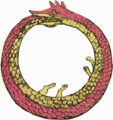Eternity
This article has multiple issues. Please help improve it or discuss these issues on the talk page. (Learn how and when to remove these template messages)
(Learn how and when to remove this template message)
|

Eternity in common parlance is an infinitely long period of time. In classical philosophy, however, eternity is defined as what exists outside time while sempiternity is the concept that corresponds to the colloquial definition of eternity.
Eternity is an important concept in many religions, where the god or gods are said to endure eternally. Some, such as Aristotle, would say the same about the natural cosmos in regard to both past and future eternal duration, and like the eternal Platonic forms, immutability was considered essential.[1]
Philosophy[edit]
Aristotle argued that the cosmos has no beginning. In Aristotle's Metaphysics, eternity is the unmoved mover (God), understood as the gradient of total synergy ("produces motion by being loved").[2] Boethius defined eternity as "simultaneously full and perfect possession of interminable life".[3]
Symbolism[edit]
Eternity is often symbolized by the image of a snake swallowing its own tail, known as the Ouroboros (or Uroboros). The circle is also commonly used as a symbol for eternity, as is the mathematical symbol of infinity, .[citation needed] Symbolically, it suggests that Eternity has no beginning or end.
The Ouroboros
The "endless knot," a symbol of eternity used in Tibetan Buddhism
Infinity symbol variations
See also[edit]
| Wikiquote has quotations related to: Eternity |
| Wikimedia Commons has media related to Eternity. |
- Aeon
- Armenian eternity sign
- Chronology of the universe
- Eternalism (philosophy of time)
- Eternal return
- God and eternity
- Philosophical presentism
- Planck epoch
- Time perception
- Temporal finitism
References[edit]
- ^ "Stanford Encyclopedia of Philosophy, Eternity". Plato.stanford.edu. Retrieved 2016-06-13.
- ^ Yu, Jiyuan The Structure of Being in Aristotle’s Metaphysics Springer, 2003, p. 188
- ^ Boedder, Bernard. "Natural Theology". University of Notre Dame. Retrieved March 15, 2015.
Aeternitas est interminablis vitae tota simul et perfecta possessio
External links[edit]
| Look up eternity in Wiktionary, the free dictionary. |
- http://plato.stanford.edu/entries/eternity/ Entry in the Stanford Encyclopedia of Philosophy on Eternity.
- http://www.iep.utm.edu/g/god-time.htm Entry in the Internet Encyclopedia of Philosophy on the relationship between God and Time.





